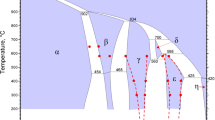Abstract
The diffusion coefficient of insoluble carbon in zirconium oxides has been obtained for the temperature range of 900–1000°C. There are no published data on the diffusion of insoluble impurities; these data are of current interest for the diffusion theory and nuclear technologies. Tracer atoms 13C have been introduced into oxides by means of ion implantation and the kinetics of their emission from the samples in the process of annealing in air has been analyzed. The measurements have been performed using the methods of nuclear microanalysis and X-ray photoelectron spectroscopy. The diffusion activation energy is 2.7 eV and the carbon diffusion coefficient is about six orders of magnitude smaller than that for oxygen self-diffusion in the same systems. This result indicates the strong anomaly of the diffusion properties of carbon in oxides. As a result, zirconium oxides cannot be used in some nuclear technologies, in particular, as a material of sources for accelerators of short-lived carbon isotopes.
Similar content being viewed by others
References
U. Koester, Eur. Phys. J. A 15, 255 (2002).
U. Koester, O. Arndt, E. Bouquerel, et al., Nucl. Instrum. Methods Phys. Res. B 266, 4229 (2008).
K. Perajarvi, U. C. Bergmann, V. Fedoseyev, et al., Nucl. Instrum. Methods Phys. Res. B 204, 272 (2003).
U. Koester, U. C. Bergmann, D. Carminati, et al., Nucl. Instrum. Methods Phys. Res. B 204, 303 (2003).
R. Doshi, J. L. Routbort, and C. B. Alcockm, Def. Dif. Forum 127–128, 39 (1995).
U. Brossmann, G. Knoner, H. E. Schaefer, et al., Rev. Adv. Mater. Sci. 6, 7 (2004).
V. B. Vykhodets, T. E. Kurennykh, A. S. Lakhtin, et al., Solid State Phenom. 138, 119 (2008).
V. N. Volkov, V. B. Vykhodets, I. K. Golubkov, et al., Nucl. Instrum. Methods Phys. Res. 205, 73 (1983).
Y. Miyagawa, S. Nakao, M. Ikeyama, et al., Nucl. Instrum. Methods Phys. Res. B 121, 340 (1997).
V. S. Vladimirov, Equations of Mathematical Physics (Nauka, Moscow, 1967; Dekker, New York, 1971).
V. P. Gladkov, V. S. Zotov, and D. M. Skorov, At. Energ. 34, 290 (1973).
Author information
Authors and Affiliations
Corresponding author
Additional information
Original Russian Text © V.B. Vykhodets, T.E. Kurennykh, A.G. Kesarev, M.V. Kuznetsov, V.V. Kondrat’ev, C. Hülsen, U. Koester, 2011, published in Pis’ma v Zhurnal Eksperimental’noi i Teoreticheskoi Fiziki, 2011, Vol. 93, No. 1, pp. 8–12.
Rights and permissions
About this article
Cite this article
Vykhodets, V.B., Kurennykh, T.E., Kesarev, A.G. et al. Diffusion of insoluble carbon in zirconium oxides. Jetp Lett. 93, 5–9 (2011). https://doi.org/10.1134/S0021364011010085
Received:
Published:
Issue Date:
DOI: https://doi.org/10.1134/S0021364011010085




